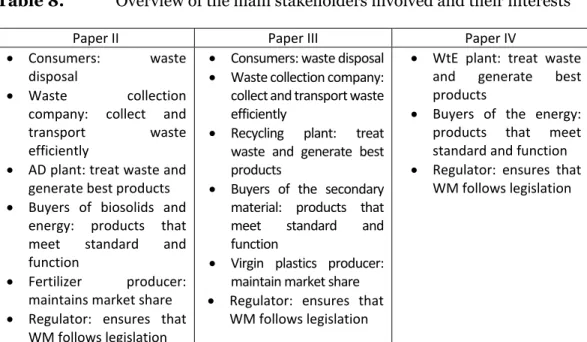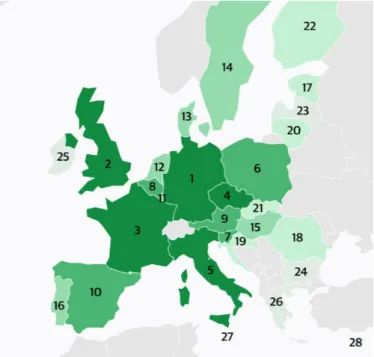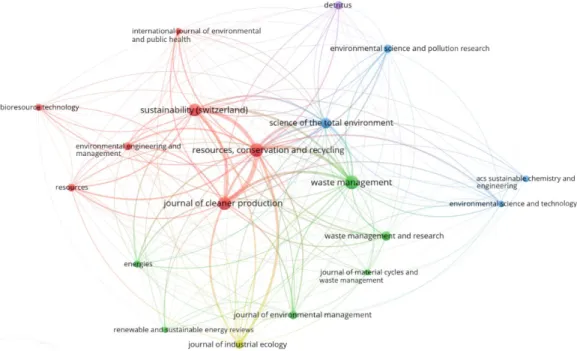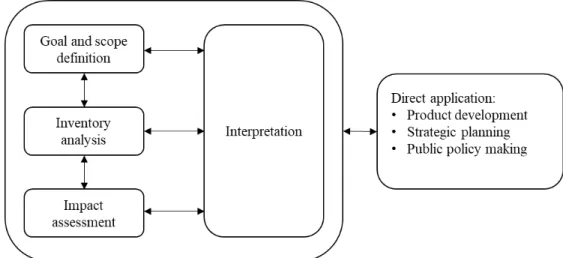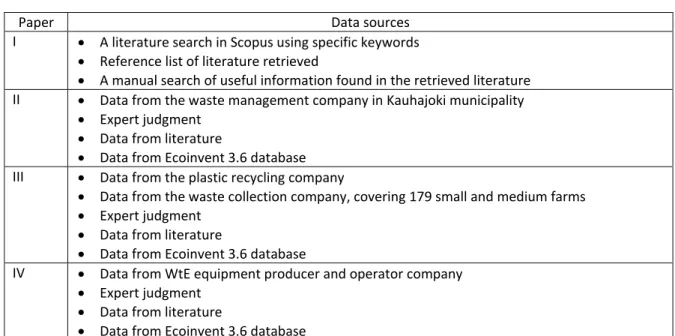Life cycle assessment (LCA) was the main tool used to evaluate environmental impacts of different circular scenarios. Keywords: circular economy, circular waste management, closed loop, life cycle assessment, life cycle costing, optimization problem. When the big things feel out of control, focus on what you love right under your nose.” - The boy, the mole, the fox and the horse.
MOO Multi-Objective Optimization MW-NL New Mixed Waste Legislation MW-OL Old Mixed Waste Legislation PSS Product Service System SCM Supply Chain Management SLCC Social Life Cycle Cost TA Land Acidification WC Water Consumption WM Waste management WtE Waste to energy. Multi-objective optimization to improve energy, economic and environmental life cycle assessment in waste-to-energy plant.
Circular economy
Because CE requires system-level change, it involves multiple stakeholders addressing the entire supply chain, including raw material extraction, design, production, consumption, and waste management systems (Reike et al., 2018); that is, to be successful, CE requires the active involvement of stakeholders through top-down and bottom-up approaches (Grafström & Aasma, 2021). Indeed, it may be technically impossible to go fully circular, due to the laws of thermodynamics, because infinite recycling may require tremendous energy and will be incomplete due to the waste of by-products (Korhonen, Nuur, et al., 2018 ; van den Bergh, 2020). Organizations still view circularity as a cost driver; about half of managers surveyed in a study by (Liebig et al., 2012) said that circular attitudes are preventive measures to avoid stricter regulation in the future that could be more expensive.
However, more circular approaches have also been shown to be financially viable; companies like Hewlett-Packard can get about 9% higher net profit margin (Liebig et al., 2012). A concrete example can be found in Interface, a global flooring manufacturer that only learned the hard way to apply the right circle approach after years of using the wrong circle approach (Atasu et al., 2021).
Circular economy and waste management: Prior works
At an academic level, the interest in CE and WM can be illustrated by the results of a literature search in Scopus using the keywords "circular economy" AND "waste management". The search was conducted for English documents in the years 2016–. The results of bibliographic linking from the academic research scientific field can be evaluated according to the circular classification made by the Politico media. Countries are ranked based on the generation of municipal waste (kg/year/inhabitant), food waste (kg/year/inhabitant), municipal recycling rate, proportion of marketed goods that can be recycled, material reuse rate, CE-related patents, and investment in the CE sector. Benefits can be achieved by avoiding production that consumes virgin materials by substituting recycled material or substituting energy from waste processing.
The tool can be combined with life cycle costing (LCC) to provide more comprehensive insights into the environment and the economy. LCC itself can be divided into conventional LCC (CLCC), environmental LCC (ELCC) and social LCC (LCC) (Hunkeler et al., 2008).
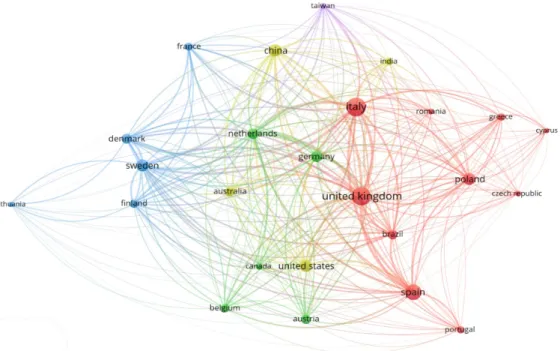
Aim and thesis structure
The continuous efforts for continuous change and improvement in the waste management sector create a need for LCA models, and the shifting trends towards circularity make it important to study how these modifications affect environmental and economic outcomes. RQ.2 What are the environmental and economic impacts of implementing a more circular waste management practice. Implementing a more circular strategy is generally seen as more environmentally friendly - and more expensive, as it requires additional planning, new infrastructure and labour.
These few aspects may cast doubt on whether a more circular strategy should be considered in the management of their waste. RQ.3 How is it possible to be more circular in energy recovery when waste management options cannot be switched.

Case studies
It describes the building blocks of CE, definition, strategies and approaches, including an extensive list of practical applications of CE at different stages of the product life cycle. Source separation aims to improve the value recovered from waste; however, waste collection is known to be costly. In Paper III, the "closing the loop" strategy was investigated through economic and environmental evaluation of recycled APWs.
This strategy was aimed at exploiting the potential of waste plastic film from the agricultural sector. Conclusions and recommendations were drawn up based on the optimized solution and the economic and environmental performance results obtained in this study.
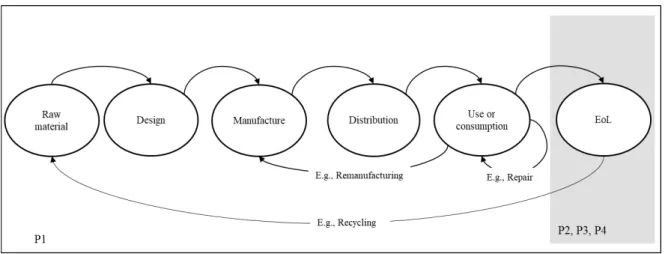
Life cycle assessment
- The goal, scope, and system description
- Life cycle inventory
- Life cycle impact assessment
- Interpretation
The boundaries are formulated based on the purpose of the study, covering resource extraction up to and including EoL management (cradle-to-grave), resource extraction up to the manufacturing stage (cradle-to-gate) or only the manufacturing stage (gate-to -gate) (Cao, 2017). The environmental impacts of the replaced products are quantified, and the avoidance of these impacts due to replacement is credited to the waste treatment process (Brander & Wylie, 2011). The second phase focuses on the development of the system model in accordance with the defined purpose and scope.
It shows a flow of different stages of the product life cycle as well as inputs and outputs of energy and resource/material (see Figure 7). Based on the outcomes of the interpretation, it may be necessary to go back to reformulating the purpose and scope, as well as refining the model at LCI and LCIA phases.
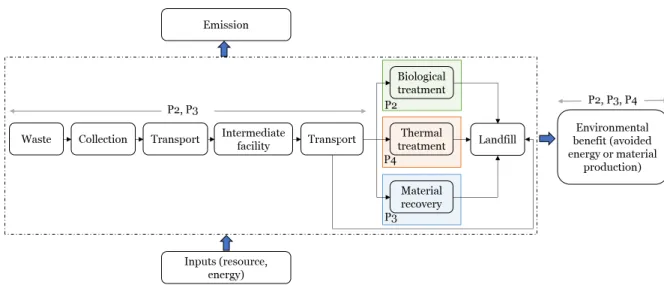
Life cycle costing and optimization problem
Circular economy and waste management
In Paper I, it was argued that CE is more than EoL management, rather it encompasses the value chain through which resources or materials flow. CE can create connections between its building blocks and build new paradigms for how we focus on preserving the value of products or materials along the value chain. Although the product life cycle is viewed as a whole system (from raw material extraction to EoL management), CE adoption patterns can occur at any stage of the value chain.
These adoption models became one of the main contributions of Paper I, which contextualized CE within a specific level of the value chain to help interested actors or stakeholders navigate their approach to circularity. CE goes beyond EoL management because attempts to conserve materials or resources can be applied at any point in the value chain; thus, different stakeholders throughout the value chain can move to circularity by implementing different models of circular adoption.
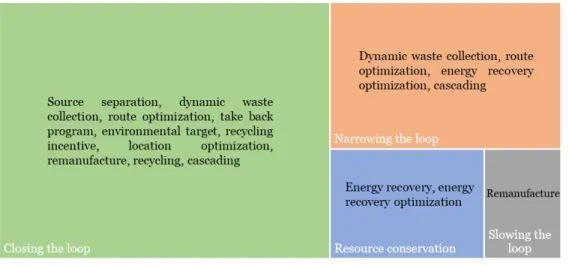
Environmental and economic impacts of different waste
Most (about 60%) of the practices could be classified as closing the loop, while lowering the loop was the lowest proportion (about 12%) of the practices. Paper The effects of the more circular approach Environment Economy Technology Environment The effects of the alternative system Economy Technology FU. Because emphasis was placed on the effect of switching to source-separated collection of bio-waste, a fair comparison can only be achieved when the old system (where the bio-waste was collected together with other waste as mixed waste) was also assessed. The studies were classified into i) bio-waste in the mixed waste according to the old legislation (MW-OL), ii) source-separated bio-waste according to the new legislation (B-NL) and iii) mixed waste without bio-waste under the new legislation (MW-NL).
When the results were examined in detail, the collection and transport of the circular approach turned out to be slightly higher costs. The case study in Paper II also showed that most collection points were concentrated rather than scattered.

Assumptions, sensitivity analysis, and scenario analysis
This means that the secondary material has the same quality and acceptability as the primary material, which could lead to an overestimation of the environmental benefits (Gala et al., 2015). Its purpose is to determine how results change as a result of changing input values (Bisinella et al., 2016). Changing the marginal energy source to a more sustainable source (a mix of wood, wind, nuclear) and a fossil source (a mix of nuclear, natural gas and black coal).
In Paper III, there were small environmental and economic performance gains from LNG compared to oil. The modification of incoming waste in Document IV presented different results for environmental, energy and economic aspects.
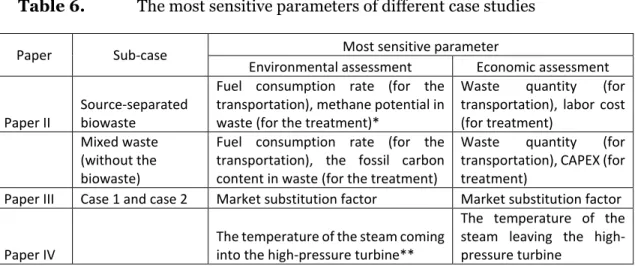
Implications for stakeholders
Exploring the controversies in the conceptualization of the circular economy with an emphasis on the history and possibilities of preserving the value of resources. 85] Kemp, R. An example of a “managed transition”: The transformation of the waste management subsystem in the Netherlands in ILehmann-Waffenschmidt M. With the new circular economy (CE) paradigm, waste is seen as a resource, so the concept of end-of-life must be ( EoL) to be gradually eliminated by processing the residual value of waste (Geissdoerfer et al., 2017).
The price of a single bin (€), lifetime of a bin (year), number of bins and annual usage rate (Mg yr−1) are represented by Cbin, Lsbin, nbin and AURbin, respectively. Before the new law comes into force, mixed waste is treated at WtE. The new law will address biological waste in AD and mixed waste remaining in WtE. The treatment cost using WtE associated with MW-OL was €79 Mg−1 total waste. Wilts H, von Gries N and Bahn-Walkowiak B (2016) From waste management to resource efficiency – the need for policy mixes.
It extends conventional life cycle costing (LCC) to be consistent with the system boundaries and the functional unit (FU) of life cycle assessment (LCA) (Martinez-Sanchez et al., 2015). The main objectives of this study are achieved by focusing on the following objectives: i) quantifying the potential environmental and economic impacts of bale packaging waste recycling, ii) investigating the contribution of key processes to environmental and economic performance, and iii) identifying critical parameters through sensitivity analysis. The impurity was estimated to be about 6% by weight after being manually sorted (Briassoulis et al., 2012). One of the key phases in LCA is to collect all input and output data related to the process.
A global sensitivity analysis was applied to determine how the outputs differed due to the change in the inputs (Bisinella et al., 2016). The robustness of the LCA with respect to the background system is tested through scenario analysis (Rigamonti et al., 2014). This trend was confirmed by Cascone et al. 2010), who showed that the contribution of the collection phase in the recycling system was less than 5% of the total impact.
The collection contributes little to the environmental impact; however, it is one of the key processes for economic performance. Uncertainties associated with the identification of marginal energy technology in life cycle assessments. 5. Sensitivity results of (a) efficiency, (b) cost, and (c) environmental impact due to variations of decision variables.
The second type of scenario used change in the source of the marginal energy mix.
